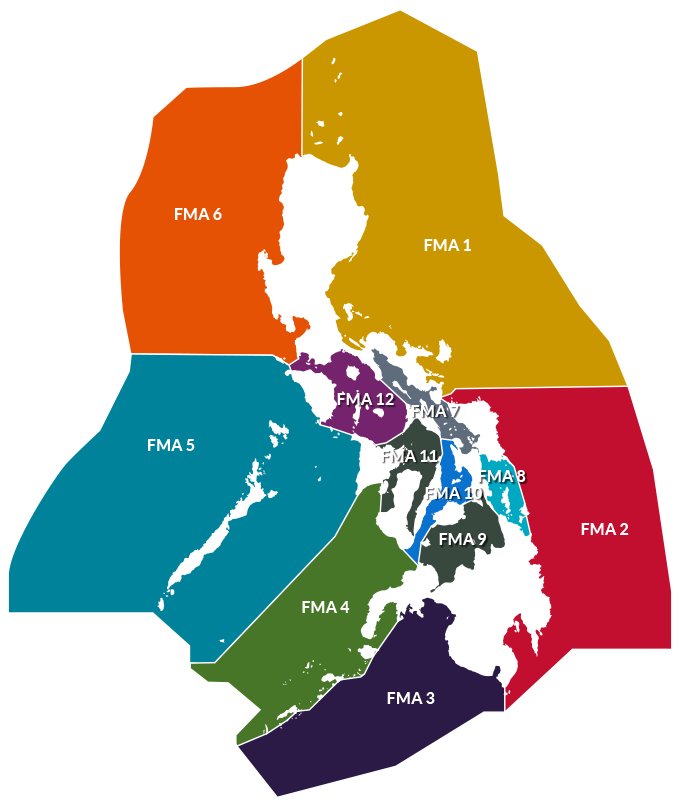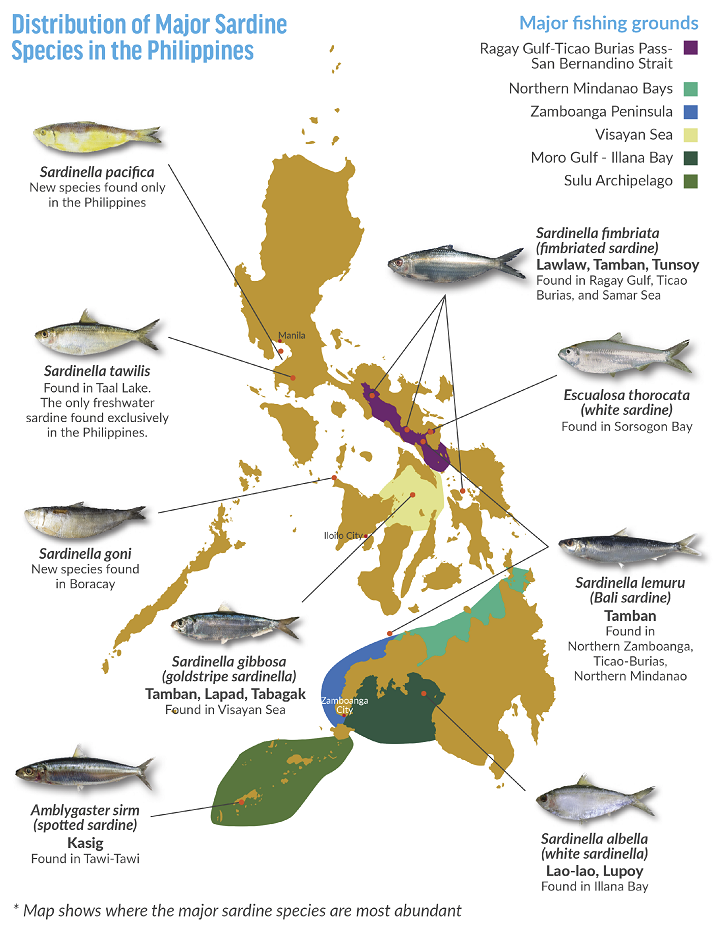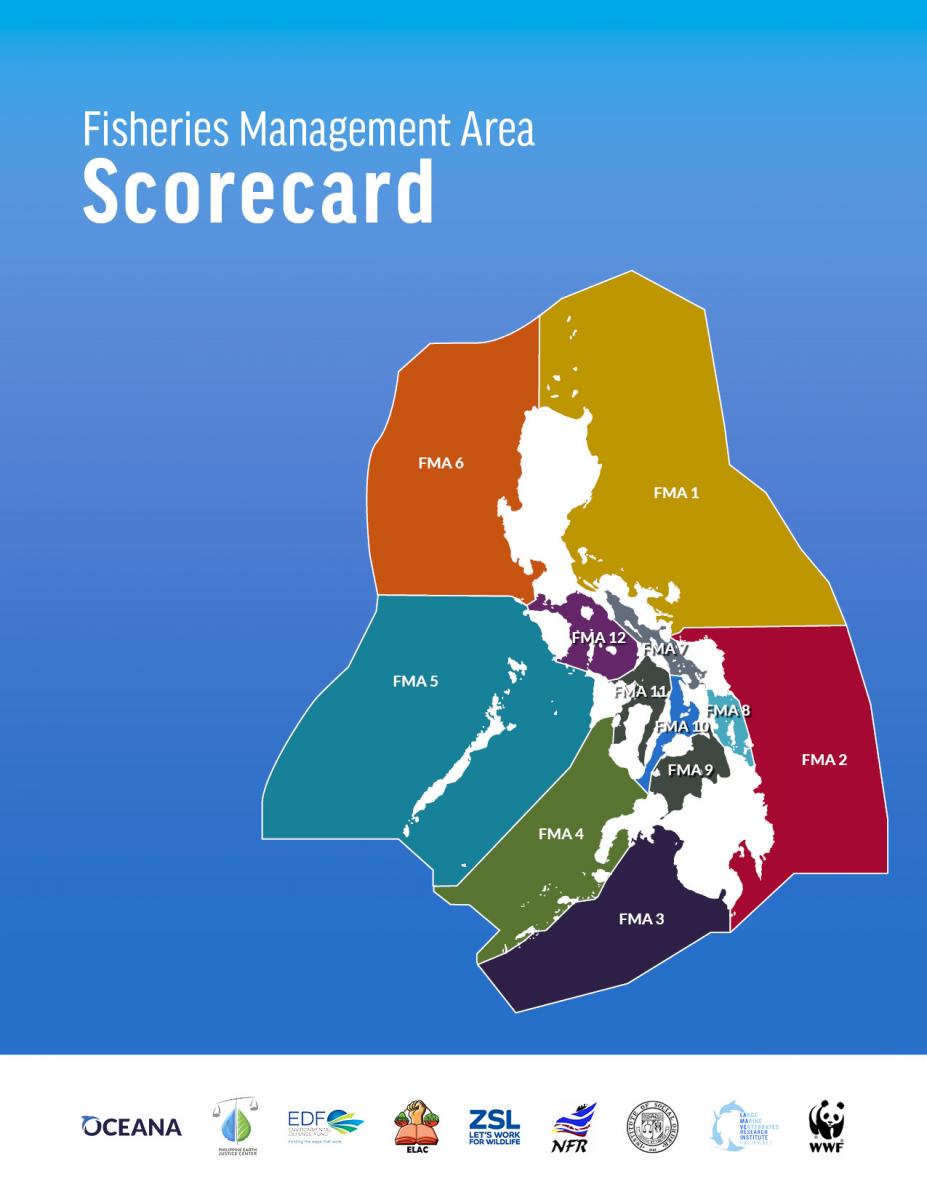Sardines Implementing Regulations
Establish National Rules on Fisheries Management Areas/Protect Sardines
SHARE TO SHOW YOUR SUPPORT:
Overview
Establish National Rules on Fisheries Management Areas/Protect Sardines
The Philippines formally established the Fisheries Management Areas (FMAs) in the Philippines through the Fisheries Administrative Order No. 263 issued by the Department of Agriculture – Bureau of Fisheries and Aquatic Resources. It established 12 Fisheries Management Areas (FMAs) covering all Philippine waters based on considerations of stocks boundary, range, administrative subdivisions, and distribution of fisheries. The policy regulation directs all coastal local government units, municipal fisherfolks, civil society organizations, academe, and key stakeholders to take on shared responsibilities for the conservation and sustainable management of fishery resources. Within Fisheries Management Areas and consistent with the mandates, the Fisheries Bureau and local government units shall work harmoniously with other stakeholders to manage the straddling and shared fish stocks under their jurisdiction. Oceana worked on the establishment and implementation of Fisheries Management Areas mechanisms to pave the way for science-based, participatory, and transparent governance framework in restoring the ocean’s abundance, managing the resources, while making sure that coastal communities are equitably benefiting from these. These intend to address overfishing in two-thirds of the country’s fishing grounds and the multiple anthropogenic pressures facing our oceans. Most of these have been caused by illegal fishing, habitat destruction, pollution, and the impact of climate change. In the Fisheries Management Area, the members of the Management Body are mandated to draw up Management Plans that are science-based, and evaluate the advice of the Scientific Advisory Group, and from consultations with the key stakeholders.

Learn more, download the brochure inserts here and here
Many of the FMAs established count on sardines as among the dominant fish species
The Philippines is a rich marine biodiversity area with nine major sardine species fueling a thriving industry that produced 344,730,201 kilograms, valued at P7.43 billion in 2015. Sold fresh and dripping in seaside markets, and canned and dried nutrient-packed sardines are among the most affordable and highly nutritious protein sources for Filipinos. However, recent studies show that sardines are being overfished. Various data reveal an alarming decline in fish stocks due to heavy fishing pressure and environmental changes. Existing policy measures such as the declaration of closed season in some areas are not enough to protect this important fishery, especially the spawning fish, and ensure its sustainable supply. According to studies, the overexploitation of sardines also caused the species to spawn and mature early at a relatively smaller size. After the strong push from Oceana and partner networks for its promulgation, the Department of Agriculture-Bureau of Fisheries and Aquatic Resources approved the National Sardines Management Plan (‘Plan’) in May 2020. With the Plan in place and the Fisheries Management Areas mechanism being implemented in sardines-producing areas, Oceana is working for this top fisheries in the country to get its fair share of sustainable management. Under the Fisheries Management Areas mechanism, the science-based indicators for the sustainable management of sardine stocks, and equitable distribution of benefits especially among sardine fisherfolk communities will be integrated in the sardine fisheries management plan. The Plan aims to achieve the following main objectives:
- Sustained Ecological Wellbeing
- Improved science-based indicators for the sustainability of sardine stocks by establishing reference points and reducing juvenile catch
- Enhanced Human Wellbeing
- Improved livelihood of sardine fisherfolks by reducing poverty and post-harvest losses while increasing their income through diversified alternative livelihood
- Stronger Policies and Governance
- Strengthened science-based management for sustainable sardine fisheries through:
- – Harvest control rules
- – Collaborative data collection and accessible fishery information
- – Increased awareness and implementation of laws and policies
- – Implementation of the National Sardines Management Plan in all sardine fishing areas
- – Electronic catch documentation and traceability system
- – Program on seal of good governance on fisheries management
- Strengthened science-based management for sustainable sardine fisheries through:

Philippines Requires Rebuilding of Sardine Fisheries Nationwide!
Following campaigning by Oceana and our partners, the Philippine government announced it will require all 12 of the country’s fisheries management areas (FMAs) to implement the National Sardines Management Plan to rebuild sardine fisheries. Sardines are a key resource in the Philippines, accounting for 15% of the total fish catch and the nation’s marine fisheries. They are also an affordable, nutrient-rich protein, making them a popular choice in many Filipino households. This high commercial demand, however, has led to rampant overfishing and population decline.
Oceana advocated for this science-based management Plan, which was approved on May 15, 2020, to help restore the health and long-term abundance of the species. The comprehensive plan includes rules for catching sardines, closed seasons, and limits on juvenile catch. It also requires measures to empower artisanal fishers, such as opportunities for fishers to generate alternative income during closed seasons. Oceana will continue to work with artisanal fishers, coastal communities, and governmental officials to ensure the plan is properly implemented across the FMAs.
Updates:
- In line with the approved Sardines Plan, FMA 7, 11, and FMA 12 already integrated the Sardines plan into the overall FMA Plan.
- 21 local government units in Samar through the Alliance of Samar Bays and Channels (ALSBACh) and the Samar Sea Alliance for Fisheries Management and Development (SASAFMD) passed resolutions to localize the implementation of the National Sardines Management Plan.
- 6 local government units in Northern Samar (San Isidro, Victoria, Allen, San Antonio, Capul, and San Vicente), through their local chief executives issued an Executive Order localizing the Sardines Plan implementation in their respective municipalities. They are also members of the San Bernardino LGU Alliance of Northern Samar (SaBeLANS).
Resources
Ating Pagyamanin ang Sardinas
Let Us Aim for Sardine Abundance
Payamanin ang Sardinas
What is an FMA?
Sardines
Sardines from the Sea: A Short Documentary

On January 28, 2019, the Department of Agriculture- Bureau of Fisheries and Aquatic Resources (DA-BFAR) issued the Fisheries Administrative Order (FAO) No. 263 which established the 12 fisheries management areas (FMAs) covering all Philippine waters. The FMA system seeks to involve all coastal local government units and key sectors as fisheries managers to take on the shared responsibilities for the conservation and sustainable management of fishery resources in the country.
The FMA Scorecard is an assessment and monitoring tool designed to help and recommend measures for effective and sustainable management for the 12 Fisheries Management Areas (FMAs) in the Philippines. Using key indicators based on good governance principles of transparency, accountability and public participation, and predictability under the Rule of Law and in order to determine compliance status and effective governance of the FMAs, this Scorecard serves as: (1) Monitoring and evaluation tool in the FMA implementation, (2) Self-assessment tool, (3) Outline in the yearly report by the FMA Management Body, and (4) Participatory process/ venue in the FMA implementation across all sectors.
The FMA Scorecard Evaluator’s Guide provides the steps and process on how the FMA Scorecard shall be used.
News & Reports
Press Releases
December 13, 2023
Restored fisheries abundance should mitigate hunger and poverty – Oceana
